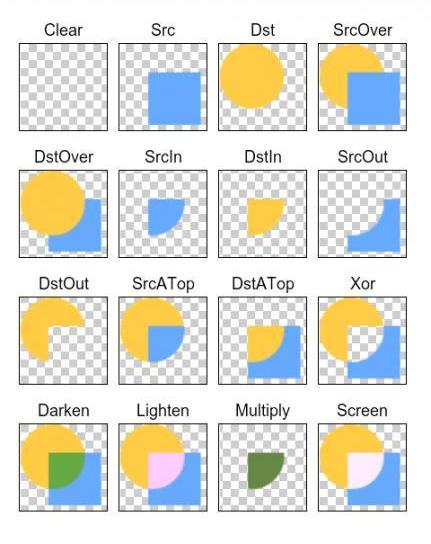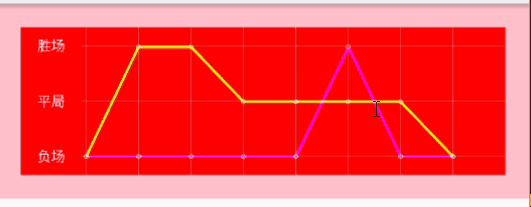Android自定义控件实现折线图 Android自定义控件实现折线图
王世晖 人气:0本文实例实现一个如下图所示的Android折线图,供大家参考,具体内容如下



首先是控件绘图区域的划分,控件左边取一小部分(控件总宽度的八分之一)绘制表头,右边剩余的部分绘制表格
确定表格的行列数,首先绘制一个三行八列的网格,设置好行列的坐标后开始绘制
/*绘制三条横线*/
for(int i=0;i<3;i++){
canvas.drawLine(textWide, mLineYs[i], totalWidth, mLineYs[i], mPaintLine);
}
/*绘制八条竖线*/
for(int i=0;i<8;i++){
canvas.drawLine(mLineXs[i], 0, mLineXs[i], totalHeight, mPaintLine);
}
网格绘制完成后,开始绘制折线图
根据输入的节点数据,分别绘制两条折线
通过canvas的drawLine方法依次连接两点即可
在每个数据节点处绘制一个小圆,突出显示
/*绘制第一条折线的路径*/
for (int i = 0; i < mPerformance_1.length - 1; i++) {
/*折线图的折线的画笔设置粗一点*/
mPaintLine.setStrokeWidth(5);
/*计算当前节点的坐标值*/
float prePointX =mLineXs[i];
float prePointY =mLineYs[2] - (mLineYs[2] - mLineYs[mPerformance_1[i].type]) * animCurrentValue;
/*计算下一个节点的坐标值*/
float nextPointX=mLineXs[i + 1];
float nextPointY=mLineYs[2] - (mLineYs[2] - mLineYs[mPerformance_1[i + 1].type]) * animCurrentValue;
/*连接当前坐标和下一个坐标,绘制线段*/
canvas.drawLine(prePointX, prePointY, nextPointX, nextPointY, mPaintLine1);
/*当前节点坐标处绘制小圆*/
canvas.drawCircle(prePointX, prePointY, mSmallDotRadius, mPointPaint);
}
两条折线重合的地方,需要特殊考虑,比如希望两条折线重合的地方折线变为白色
设置下两条折线的画笔即可
mPaintLine2.setXfermode(new PorterDuffXfermode(PorterDuff.Mode.SCREEN)); mPaintLine1.setXfermode(new PorterDuffXfermode(PorterDuff.Mode.SCREEN));

测试代码及效果;
final Random random=new Random();
final LineChartView myView=(LineChartView)findViewById(R.id.custom_view);
final LineChartView.Performance[] performances1=new LineChartView.Performance[8];
final LineChartView.Performance[] performances2=new LineChartView.Performance[8];
myView.setOnClickListener(new View.OnClickListener(){
@Override
public void onClick(View v){
for(int i=0;i<performances1.length;i++){
switch (random.nextInt(2016)%3){
case 0:
performances1[i]= LineChartView.Performance.WIN;
break;
case 1:
performances1[i]= LineChartView.Performance.DRAW;
break;
case 2:
performances1[i]= LineChartView.Performance.LOSE;
break;
default:
performances1[i]= LineChartView.Performance.LOSE;
break;
}
switch (random.nextInt(2016)%3){
case 0:
performances2[i]= LineChartView.Performance.WIN;
break;
case 1:
performances2[i]= LineChartView.Performance.DRAW;
break;
case 2:
performances2[i]= LineChartView.Performance.LOSE;
break;
default:
performances1[i]= LineChartView.Performance.LOSE;
break;
}
}
myView.setPerformances(performances1,performances2);
}
});

完整代码如下:
public class LineChartView extends View {
private Context context;
/*动画插值器*/
DecelerateInterpolator mDecelerateInterpolator = new DecelerateInterpolator();
/*动画刷新的次数*/
private int mDuration = 10;
/*当前动画进度值*/
private int mCurrentTime = 0;
private Performance[] mPerformance_1, mPerformance_2;
/*两条折线的颜色*/
private int mLineColor1, mLineColor2;
/*绘制表头文字画笔*/
private Paint mPaintText = new Paint();
/*绘制表格的画笔*/
private Paint mPaintLine = new Paint();
/*第一条折线的画笔*/
private Paint mPaintLine1 =new Paint();
/*第二条折线的画笔*/
private Paint mPaintLine2 =new Paint();
/*坐标点的小圆点画笔*/
private Paint mPointPaint = new Paint();
private float mSmallDotRadius = 4;
private TypedValue typedValue;
private int mPaintClolor;
/*Handler刷新界面产生动画效果*/
private Handler mHandler = new Handler();
private Runnable mAnimation = new Runnable() {
@Override
public void run() {
if (mCurrentTime < mDuration) {
mCurrentTime++;
LineChartView.this.invalidate();
}
}
};
public LineChartView(Context context) {
super(context);
this.context=context;
init();
}
public LineChartView(Context context, AttributeSet attrs) {
super(context, attrs);
this.context=context;
init();
}
public LineChartView(Context context, AttributeSet attrs, int defStyleAttr) {
super(context, attrs, defStyleAttr);
this.context=context;
init();
}
public enum Performance {
WIN(0),
DRAW(1),
LOSE(2);
public int type;
Performance(int type) {
this.type = type;
}
}
public void setPerformances(Performance[] performance1, Performance[] performance2) {
if (performance1 == null) {
performance1 = new Performance[0];
}
if (performance2 == null) {
performance2 = new Performance[0];
}
mPerformance_1 = Arrays.copyOf(performance1, performance1.length > 8 ? 8 : performance1.length);
mPerformance_2 = Arrays.copyOf(performance2, performance2.length > 8 ? 8 : performance2.length);
if (isShown()) {
mCurrentTime = 0;
this.invalidate();
}
}
/**
* 设置折线1的颜色
*
* @param mLineColor1
*/
public void setLineColor1(int mLineColor1) {
this.mLineColor1 = mLineColor1;
}
/**
* 设置折线2的颜色
*
* @param mLineColor2
*/
public void setLineColor2(int mLineColor2) {
this.mLineColor2 = mLineColor2;
}
private void init() {
mLineColor1=Color.BLUE;
mLineColor2 = Color.GREEN;
typedValue=new TypedValue();
context.getTheme().resolveAttribute(R.attr.title_bar,typedValue,true);
mPaintClolor =getResources().getColor(typedValue.resourceId);
final LineChartView.Performance[] performances1=new LineChartView.Performance[8];
final LineChartView.Performance[] performances2=new LineChartView.Performance[8];
final Random random=new Random();
for(int i=0;i<performances1.length;i++){
switch (random.nextInt(2016)%3){
case 0:
performances1[i]= LineChartView.Performance.WIN;
break;
case 1:
performances1[i]= LineChartView.Performance.DRAW;
break;
case 2:
performances1[i]= LineChartView.Performance.LOSE;
break;
default:
performances1[i]= LineChartView.Performance.LOSE;
break;
}
switch (random.nextInt(2016)%3){
case 0:
performances2[i]= LineChartView.Performance.WIN;
break;
case 1:
performances2[i]= LineChartView.Performance.DRAW;
break;
case 2:
performances2[i]= LineChartView.Performance.LOSE;
break;
default:
performances1[i]= LineChartView.Performance.LOSE;
break;
}
}
setPerformances(performances1,performances2);
}
/**
* @param canvas
*/
@Override
protected void onDraw(Canvas canvas) {
super.onDraw(canvas);
/*获取控件总宽高*/
float totalWidth = getWidth();
float totalHeight = getHeight();
/*左边取总宽度的八分之一绘制表格头部*/
float textWide = totalWidth / 8;
/*左边留一点空白*/
float left_offset = 10;
/*折线图的总宽度等于控件的总宽度减去表头和留白*/
float chartWide = totalWidth - textWide - left_offset;
/*一共三行,设置每一行的垂直坐标*/
float[] mLineYs = new float[]{totalHeight / 8, totalHeight / 2, totalHeight * 7 / 8};
/*一共八列,设置每一列的水平坐标*/
float[] mLineXs = new float[]{
textWide + left_offset + chartWide * 0 / 8,
textWide + left_offset + chartWide * 1 / 8,
textWide + left_offset + chartWide * 2 / 8,
textWide + left_offset + chartWide * 3 / 8,
textWide + left_offset + chartWide * 4 / 8,
textWide + left_offset + chartWide * 5 / 8,
textWide + left_offset + chartWide * 6 / 8,
textWide + left_offset + chartWide * 7 / 8,
};
/*绘制表头文字*/
mPaintText.setStyle(Paint.Style.FILL);
mPaintText.setColor(mPaintClolor);
mPaintText.setAlpha(226);
mPaintText.setTextSize(28);
/*从中间开始绘制*/
mPaintText.setTextAlign(Paint.Align.CENTER);
/*测量文字大小,并计算偏移量*/
Paint.FontMetrics fontMetrics = mPaintText.getFontMetrics();
float textBaseLineOffset = (fontMetrics.bottom - fontMetrics.top) / 2 - fontMetrics.bottom;
canvas.drawText("胜场", textWide / 2, mLineYs[0] + textBaseLineOffset, mPaintText);
canvas.drawText("平局", textWide / 2, mLineYs[1] + textBaseLineOffset, mPaintText);
canvas.drawText("负场", textWide / 2, mLineYs[2] + textBaseLineOffset, mPaintText);
/*绘制表格画笔设置*/
mPaintLine.setStyle(Paint.Style.STROKE);
mPaintLine.setAntiAlias(true);
mPaintLine.setColor(mPaintClolor);
mPaintLine.setAlpha(80);
mPaintLine.setStrokeWidth(1);
/*开始绘制表格*/
/*绘制三条横线*/
for(int i=0;i<3;i++){
canvas.drawLine(textWide, mLineYs[i], totalWidth, mLineYs[i], mPaintLine);
}
/*绘制八条竖线*/
for(int i=0;i<8;i++){
canvas.drawLine(mLineXs[i], 0, mLineXs[i], totalHeight, mPaintLine);
}
/*折线图画笔设置*/
mPaintLine1.setStyle(Paint.Style.STROKE);
/*设置透明度,取值范围为0~255,数值越小越透明,0表示完全透明*/
mPaintLine1.setAlpha(0);
mPaintLine1.setAntiAlias(true);
mPaintLine1.setColor(mLineColor1);
mPaintLine1.setStrokeWidth(5);
mPaintLine2.setStyle(Paint.Style.STROKE);
/*设置透明度,取值范围为0~255,数值越小越透明,0表示完全透明*/
mPaintLine2.setAlpha(0);
mPaintLine2.setAntiAlias(true);
mPaintLine2.setColor(mLineColor2);
mPaintLine2.setStrokeWidth(5);
if (typedValue.resourceId==R.color.white){
/*PorterDuff.Mode.SCREEN 上下层都显示。*/
mPaintLine2.setXfermode(new PorterDuffXfermode(PorterDuff.Mode.SCREEN));
mPaintLine1.setXfermode(new PorterDuffXfermode(PorterDuff.Mode.SCREEN));
}else {
/*PorterDuff.Mode.DARKEN 上下层都显示。变暗*/
mPaintLine2.setXfermode(new PorterDuffXfermode(PorterDuff.Mode.DARKEN));
mPaintLine1.setXfermode(new PorterDuffXfermode(PorterDuff.Mode.DARKEN));
}
/*画节点处的小圆点的画笔设置*/
mPointPaint.setStyle(Paint.Style.STROKE);
mPointPaint.setAntiAlias(true);
mPointPaint.setColor(mPaintClolor);
/*计算当前动画进度对应的数值*/
float animCurrentValue = mDecelerateInterpolator.getInterpolation(1.0f * mCurrentTime / mDuration);
mPaintLine.setColor(mLineColor1);
/*绘制第一条折线的路径*/
for (int i = 0; i < mPerformance_1.length - 1; i++) {
/*折线图的折线的画笔设置粗一点*/
mPaintLine.setStrokeWidth(5);
/*计算当前节点的坐标值*/
float prePointX =mLineXs[i];
float prePointY =mLineYs[2] - (mLineYs[2] - mLineYs[mPerformance_1[i].type]) * animCurrentValue;
/*计算下一个节点的坐标值*/
float nextPointX=mLineXs[i + 1];
float nextPointY=mLineYs[2] - (mLineYs[2] - mLineYs[mPerformance_1[i + 1].type]) * animCurrentValue;
/*连接当前坐标和下一个坐标,绘制线段*/
canvas.drawLine(prePointX, prePointY, nextPointX, nextPointY, mPaintLine1);
/*当前节点坐标处绘制小圆*/
canvas.drawCircle(prePointX, prePointY, mSmallDotRadius, mPointPaint);
}
/*第一个折线图的最后一个节点的坐标*/
float lastPointX=mLineXs[mPerformance_1.length - 1];
float lastPointY= mLineYs[2] - (mLineYs[2] - mLineYs[mPerformance_1[mPerformance_1.length - 1].type]) * animCurrentValue;
/*绘制最后一个节点的外围小圆*/
canvas.drawCircle(lastPointX,lastPointY ,mSmallDotRadius, mPointPaint);
/*绘制第二条折线*/
mPaintLine.setColor(mLineColor2);
for (int i = 0; i < mPerformance_2.length - 1; i++) {
/*折线图的折线的画笔设置粗一点*/
mPaintLine.setStrokeWidth(5);
/*计算当前节点的坐标值*/
float prePointX =mLineXs[i];
float prePointY =mLineYs[2] - (mLineYs[2] - mLineYs[mPerformance_2[i].type]) * animCurrentValue;
/*计算下一个节点的坐标值*/
float nextPointX=mLineXs[i + 1];
float nextPointY=mLineYs[2] - (mLineYs[2] - mLineYs[mPerformance_2[i + 1].type]) * animCurrentValue;
/*连接当前坐标和下一个坐标,绘制线段*/
canvas.drawLine(prePointX, prePointY, nextPointX, nextPointY, mPaintLine2);
/*当前节点坐标处绘制小圆*/
canvas.drawCircle(prePointX, prePointY, mSmallDotRadius, mPointPaint);
}
/*第一个折线图的最后一个节点的坐标*/
lastPointX=mLineXs[mPerformance_2.length - 1];
lastPointY= mLineYs[2] - (mLineYs[2] - mLineYs[mPerformance_2[mPerformance_2.length - 1].type]) * animCurrentValue;
/*绘制最后一个节点的外围小圆*/
canvas.drawCircle(lastPointX,lastPointY ,mSmallDotRadius, mPointPaint);
mHandler.postDelayed(mAnimation, 20);
}
}
加载全部内容